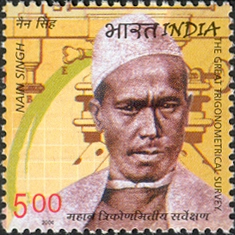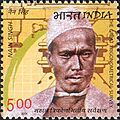Nain Singh facts for kids
Quick facts for kids
Nain Singh
|
|
|---|---|

Nain Singh on a 2004 stamp of India
|
|
| Born | 21 October 1830 Milam, Munsiyari, Pithoragarh district, Uttarakhand, India
|
| Died | 1 February 1882 (aged 51) |
| Nationality | Indian |
| Occupation | Asian explorer |
Nain Singh (born October 21, 1830 – died February 1, 1882), also known as Nain Singh Rawat, was an amazing Indian explorer. He was one of the first "pundits" (which means a wise person or scholar) hired by the British to explore the Himalayas and Central Asia.
Nain Singh came from the Johar Valley in Kumaon, India. He mapped a trade route through Ladakh to Tibet. He also figured out where Lhasa in Tibet was located and how high it was above sea level. Plus, he mapped a big part of the Brahmaputra River. He walked an incredible 1,580 miles, counting every single step!
Contents
Early Life and Training
Growing Up in Milam
Nain Singh was born in 1830 in a village called Milam. This village is in the Johar Valley in the Uttarakhand state of India. It's located at the foot of the Milam Glacier, close to the border between India and China. The people of this area, called Bhotias, often traveled for trade.
Learning About Tibet
After finishing school, Nain Singh helped his father with their trade business. He traveled with him to different places in Tibet. This helped him learn the Tibetan language and understand their customs and traditions. He also got to know the Tibetan people well. This knowledge was super helpful later when he became a "spy explorer" for the British.
Seasonal Living
Milam and other villages in the upper Johar valley are very cold. People only live there for a few months each year, from June to October. During these warmer months, the men would travel to markets in Western Tibet to trade.
Exploring Tibet
Why Explore Tibet?
In the 1800s, the British wanted to trade with Tibet. They also wanted to map Central Asia and Tibet because these areas were mostly unknown to them. However, the Chinese government had closed Tibet's borders. This made it very hard for Europeans to enter. Many tried, but most were stopped by local officials.
Because of this, a British officer named Thomas Montgomerie had a clever idea in 1862. He suggested hiring local Indian explorers, like Nain Singh, to secretly map these hidden lands.
Becoming a Secret Surveyor
Nain Singh and his cousin, Mani Singh, were chosen for this important job. They went to Dehradun, where the British Survey headquarters was located. For two years, they learned special surveying techniques.
They had to be very sneaky! They hid mercury for thermometers in bowls and kept notes inside prayer wheels. Their surveying tools were hidden in their luggage. They even used a special string of prayer beads, changed to 100 beads instead of 108. They would move one bead for every hundred steps they took. They also practiced walking with a very precise stride length of 33 inches, no matter the ground.
First Big Journey
Nain Singh's first major expedition started in 1865. He and Mani separated to cover more ground. Mani explored western Tibet, while Nain Singh bravely walked all the way to Lhasa, the capital of Tibet.
During this trip, Nain Singh figured out the height of Lhasa by boiling water. He estimated it was 3,420 meters high, which was very close to the actual height of 3,540 meters! He also used the stars to find Lhasa's exact location.
Later Expeditions
Nain Singh went on two more important expeditions:
- His second journey in 1867 explored western Tibet.
- His third and final journey, from 1873 to 1875, took him back to Lhasa using a different, more northern route.
Amazing Discoveries
During his secret surveys, Nain Singh was the first non-Tibetan to visit many legendary places in Tibet. This included the Thok Jalung goldfields, which he visited on August 26, 1867. He later said that Thok Jalung was the coldest place he had ever been!
Nain Singh was also a cousin of Kishen Singh, another famous pundit explorer.
Legacy and Recognition
Nain Singh's hard work and amazing discoveries did not go unnoticed.
- In May 1877, he received the Royal Geographic Society's Patron's Medal. This award was given "for his great journeys and Surveys in Tibet and along the Upper Brahmaputra." His work helped determine the position of Lhasa and added a lot of new knowledge to the map of Asia.
- On June 27, 2004, India honored him with a special postage stamp.
- In 2006, a book about his life was published, including three of his diaries.
- A mountain range south of Lake Pangong is named the Nain Singh Range in his honor.
- On October 21, 2017, Google celebrated his 187th birthday with a special Google Doodle on their homepage.
Nain Singh's incredible journeys helped map parts of the world that were once a mystery, making him a true pioneer of exploration.
Images for kids




